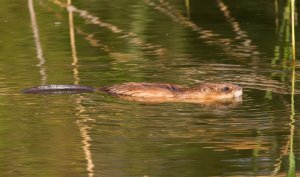Wild Wednesday: Muskrat
 Is that a beaver? That’s a question that this widespread mammal is the subject of all too often. And with their dark brown fur and semi-aquatic lifestyle, they do share some similarities with their larger relatives. However, muskrats are a separate and unique animal, a fact that becomes more obvious after a look at their long, narrow tail that is nothing like the large flat paddle tail of a beaver. In addition, instead of gnawing on wood and bark like a beaver, muskrats prefer cattails and other soft aquatic plants that they also use to build their lodge. These lodges can be a few feet high with an entrance underneath the water and are used year-round. Muskrats are amazingly well adapted to the cold Michigan weather; they can forage in the winter even under thick layers of ice. They will maintain a hole in the ice for breathing and stuff a wad of plant matter into it for protection, this structure is often called a “push-up.” Muskrats don’t have to use those push-ups as often as you might think, they are incredibly well adapted for life underwater and can stay there for up to fifteen minutes at a time! They also have webbed feet like a duck and a transparent third eyelid called a nictitating membrane that functions like built-in swim goggles. If you would like to see this incredible animal in person, you’re in luck! They can be found across the state in a wide variety of aquatic habitats, from ponds and marshes to lakes and rivers. Look for their conspicuous lodges for a hint on where to focus your search and then, particularly near dawn and dusk, look for the small brown shape of their upper back and head poking out above the surface of the water as they swim, with that distinctive thin tail wiggling along behind.
Is that a beaver? That’s a question that this widespread mammal is the subject of all too often. And with their dark brown fur and semi-aquatic lifestyle, they do share some similarities with their larger relatives. However, muskrats are a separate and unique animal, a fact that becomes more obvious after a look at their long, narrow tail that is nothing like the large flat paddle tail of a beaver. In addition, instead of gnawing on wood and bark like a beaver, muskrats prefer cattails and other soft aquatic plants that they also use to build their lodge. These lodges can be a few feet high with an entrance underneath the water and are used year-round. Muskrats are amazingly well adapted to the cold Michigan weather; they can forage in the winter even under thick layers of ice. They will maintain a hole in the ice for breathing and stuff a wad of plant matter into it for protection, this structure is often called a “push-up.” Muskrats don’t have to use those push-ups as often as you might think, they are incredibly well adapted for life underwater and can stay there for up to fifteen minutes at a time! They also have webbed feet like a duck and a transparent third eyelid called a nictitating membrane that functions like built-in swim goggles. If you would like to see this incredible animal in person, you’re in luck! They can be found across the state in a wide variety of aquatic habitats, from ponds and marshes to lakes and rivers. Look for their conspicuous lodges for a hint on where to focus your search and then, particularly near dawn and dusk, look for the small brown shape of their upper back and head poking out above the surface of the water as they swim, with that distinctive thin tail wiggling along behind.
